
Latest Updates: (scroll down for more)
A PB&J Micro Farm Update:
December 2015 - January 2016
We are in the process of renovating the
animal enclosures for new animals, and we'll be getting the
greenhouse started-up soon. Stay tuned!
April 2014
Our Nubian doe Lucy gives us an unexpected surprise: Li'l
Ricky.
Here's a video
August 2013
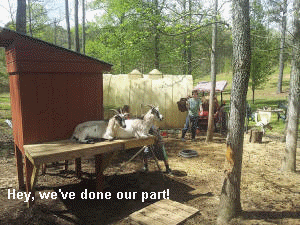 Last year was our first attempt at a real backyard garden and we
learned a lot. This year we incorporated some of our new found
knowledge and have since reaped the benefits (literally).
Last year was our first attempt at a real backyard garden and we
learned a lot. This year we incorporated some of our new found
knowledge and have since reaped the benefits (literally).
Improvements:
Last season we expanded the goat's domain to about an acre of
woods with heavy underbrush. Well, formerly with heavy
underbrush. Goats are amazing weed eaters and have completely
stripped all the honeysuckle and bushy saplings from the ground
to about 5' and up.
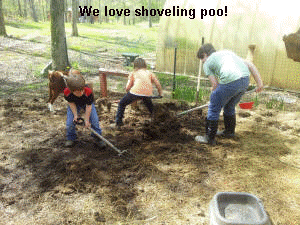 Additionally, we made the goat's
habitat a little more livable with an elevated deck on their
Kidd Kondo. Goats don't like rain and wind, and the elevation
makes them feel safe, secure, and extremely lazy. All of the
floors inside and outside are slatted so their wonderful little
fertilizing pellets drop straight through to the ground beneath.
Additionally, we made the goat's
habitat a little more livable with an elevated deck on their
Kidd Kondo. Goats don't like rain and wind, and the elevation
makes them feel safe, secure, and extremely lazy. All of the
floors inside and outside are slatted so their wonderful little
fertilizing pellets drop straight through to the ground beneath.
Pre-Season Preparations:
With a year's worth of poo accumulated in the goat pen and
chicken enclosure, we got busy shoveling, loading, and hauling
to the garden's compost pile. We
ended-up with the equivalent of a
pickup truck load of wonderfully rich organic fertilizer. We
have since used much of the pile but have another 7 months worth
of accumulation to put in the beds this fall. The kids are sooo
excited!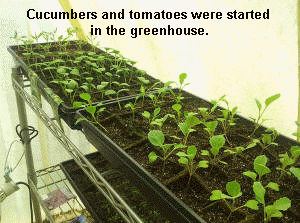
Next, with last year's
addition of a compact greenhouse, we started our own cucumbers
and tomatoes in mid March. We were so excited to plant our own
greenhouse starters that we jumped
the gun, planting after the published "last frost" date of April 15 (N
Georgia). Two days later we had frost, but we protected them and
they came through just fine. Unfortunately, the next freakish
frost (@38 degrees) got them all. Off to the nursery we went.
Planting:
Last year we learned our lesson about weeds and grass in the
beds. Without a plan and/or a lot of work, they can easily take
over a garden, e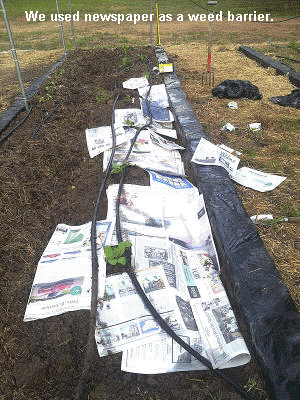 specially
if you plan to use no herbicides. This year we used the old
trick of using newspapers as a wee barrier. As of August 8, the
plan has worked perfectly. Simply place around 6 sheets of
newspaper around the plants and wet them down. Then you can
spread a layer of compost or straw on top to hold the paper in
place. Eventually the newspaper composts, so there is no waste
or mess to clean up.
specially
if you plan to use no herbicides. This year we used the old
trick of using newspapers as a wee barrier. As of August 8, the
plan has worked perfectly. Simply place around 6 sheets of
newspaper around the plants and wet them down. Then you can
spread a layer of compost or straw on top to hold the paper in
place. Eventually the newspaper composts, so there is no waste
or mess to clean up.
This is just the second year for our beds, so we are still
adding some amendments for moisture control. Otherwise, we are
using our own compost for fertilizer.
Vertical Gardening:
When we initially began researching backyard farming, we
learned about vertical gardening. There are numerous advantages
to growing vegetables vertically, but our favorite reason is not
having to bend over to pick the crops. Another advantage is the
wise use of real estate. Vertical gardening requires less space
making it a natural choice for a small garden.
For our garden, we built several sturdy trellis frames using
chain-link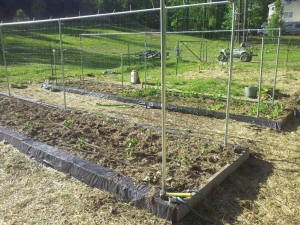 fencing support poles and hand rail hardware to connect the
poles to one another. We then attached vinyl netting to the
trellis frames with plastic ties. It's relatively inexpensive
and sturdy enough to use year after year. This year we have
trellises in all three beds supporting two varieties of
cucumbers, three varieties of tomatoes, and our coveted heirloom
pole beans.
fencing support poles and hand rail hardware to connect the
poles to one another. We then attached vinyl netting to the
trellis frames with plastic ties. It's relatively inexpensive
and sturdy enough to use year after year. This year we have
trellises in all three beds supporting two varieties of
cucumbers, three varieties of tomatoes, and our coveted heirloom
pole beans.
Specializing:
Last year we planted a wide variety of vegetables in our
garden, then
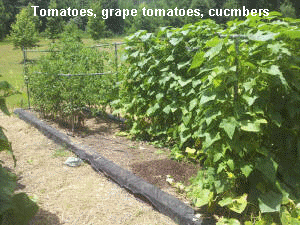 proceeded to give (or throw) much of the harvest away. We
learned the hard way that there are just certain things the kids
will eat, and other things they'd rather not. Unfortunately, we
couldn't find any pizza seeds, so we had to draw the line
somewhere. This year we decided to concentrate on things we
could preserve to eat and use in recipes year round. Tomatoes,
cucumbers, and green beans were of primary interest.
proceeded to give (or throw) much of the harvest away. We
learned the hard way that there are just certain things the kids
will eat, and other things they'd rather not. Unfortunately, we
couldn't find any pizza seeds, so we had to draw the line
somewhere. This year we decided to concentrate on things we
could preserve to eat and use in recipes year round. Tomatoes,
cucumbers, and green beans were of primary interest.
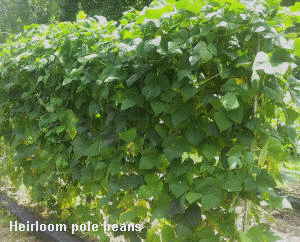 We also planted some yellow squash, zucchini, pepper,
cantaloupe, watermelon, lettuce, and spinach.
We also planted some yellow squash, zucchini, pepper,
cantaloupe, watermelon, lettuce, and spinach.
Maintenance:
As the season progressed, the garden was fairly easy to
maintain. We'd had a very wet spring which really stressed the
tomatoes. We added a calcium supplement to the soil to help
prevent "blossom spot rot," and it worked wonderfully. Last
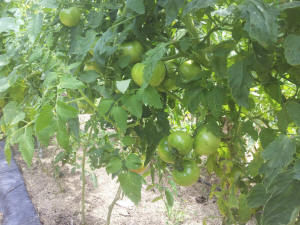 year
we threw away many tomatoes because of this little problem. We
also noticed that healthier tomato plants resist insect invasion
much better.
year
we threw away many tomatoes because of this little problem. We
also noticed that healthier tomato plants resist insect invasion
much better.
The trellis netting strained under
the weight of the tomatoes and cucumbers, so we had to place
additional plastic zip-ties along the tops of each trellis frame
for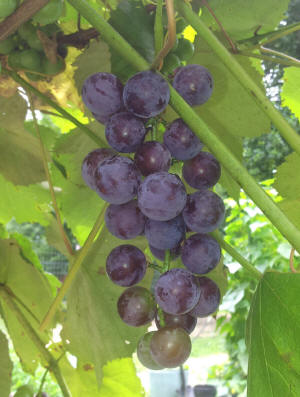 added support. The netting has performed wonderfully the entire
season and looks like it will last another season with no
problem.
added support. The netting has performed wonderfully the entire
season and looks like it will last another season with no
problem.
Grapes:
Last year we planted two varieties of grape: Riesling and
Concord. We didn't really know why, that's just what the nursery
had. We hadn't a clue the vines would start producing so soon,
and so abundantly. We used t-posts and plastic coated wire
cabling to support the vines, but have learned this season that
grapes are very heavy, and the posts were bent to the point that
grapes were actually touching the ground. To solve the problem,
we plan to add some wood fence posts to the end of each row (we
have added another this summer for a total of 3). So far this
season, we have canned Concord jam and Riesling jelly, and we
still have lots of Concord grapes on the vine.
The Harvest:
A southern garden will provide a season of harvests starting as
early
 as
late April through October. Much of the early harvest such as
lettuce and cucumbers were gobbled-up before we could blink.
Then the volume started, and we were quickly up to our ears in
green goodness. But we had a plan...
as
late April through October. Much of the early harvest such as
lettuce and cucumbers were gobbled-up before we could blink.
Then the volume started, and we were quickly up to our ears in
green goodness. But we had a plan...
Preserving:
We decided early-on that we would preserve what we couldn't eat,
either by canning or freezing. We even bought a new freezer for
the basement and a bunch of new Mason jars. We tried our hand at
canning last year with pickles and pickled peppers. We
experimented and ended-up with a variety of results, some good,
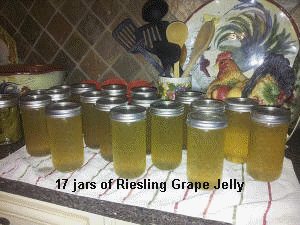 some not so good. Funny how honest kids are when they want
to be. I think we now have it down to a science.
some not so good. Funny how honest kids are when they want
to be. I think we now have it down to a science.
This year, along with pickling over 40 quarts of cucumbers and
peppers, we have frozen a good many quarts of tomatoes, green
beans, zucchini, blueberries, and corn (from the farmers
market). We have made salsa, strawberry preserves, peach
preserves, honey peach (low sugar) preserves, Concord grape jam,
and Riesling grape jelly. And guess what: WE AREN'T DONE YET!
It's Just August:
This year we have had such fun canning and freezing, we want
to keep the garden going as long as possible.
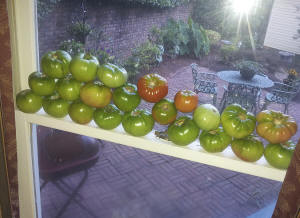 On
the first weekend of August we pulled all remaining cucumber
plants out of the beds, cleaned the vines from the trellises,
and planted a pole beans in their place. We plan to do some
pressure canning of green beans in the fall, and the way these
things grow and produce, we should have plenty. We have
harvested all the Riesling grapes and made jelly, but there are
still many Concord grapes on the vines. We're thinking Concord
grape jelly this time around. At this time, we still have around
80 tomatoes on the vine and a good many in the kitchen waiting
for a purpose. Those tha
On
the first weekend of August we pulled all remaining cucumber
plants out of the beds, cleaned the vines from the trellises,
and planted a pole beans in their place. We plan to do some
pressure canning of green beans in the fall, and the way these
things grow and produce, we should have plenty. We have
harvested all the Riesling grapes and made jelly, but there are
still many Concord grapes on the vines. We're thinking Concord
grape jelly this time around. At this time, we still have around
80 tomatoes on the vine and a good many in the kitchen waiting
for a purpose. Those tha t
don't make it into sandwiches will be frozen for later use in
soups, chili, spaghetti sauce, and salsa. Our pepper plants are
like little trees and will produce more than we can eat for some
time to come.
t
don't make it into sandwiches will be frozen for later use in
soups, chili, spaghetti sauce, and salsa. Our pepper plants are
like little trees and will produce more than we can eat for some
time to come.
Chickens -n- Goats:
We would be remiss if we didn't mention our chickens and goats.
Chickens are wonderful (although the scratch-up the pine straw
in our shrub beds, grrrr). They eat pesky insects, are very low
maintenance, fun to watch, and produce enough eggs to keep us
happy. We never have to buy eggs!
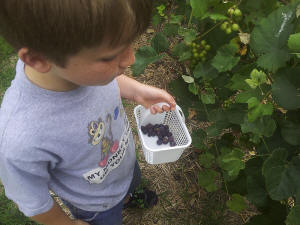
Goats, on the other hand, are a bit more work. We have a meat
goat (Henry) that we will never eat (don't name your
livestock!), a pygmy goat (Brie) that is just a pet, and a
Nubian doe (Lucy) that we hope will give us milk some day. We're
still waiting for Henry to do his job and get Lucy pregnant.
Daddy, I Like Being a Farmer:
One day as we were checking on the garden, our youngest child
John Micah said "Daddy, I like being a farmer." Well, we're not
really farmers, but we do have a new appreciation of plants and
animals and the work and knowledge it takes to grow and maintain
them. We are all learning new skills, the skills of our
grandparents. Skills that may one day come in handy.
Life on the PB&J Micro-Farm - June 1, 2012
A lot has happened since our last PB&J
Micro-Farm update.
The vegetables in the ra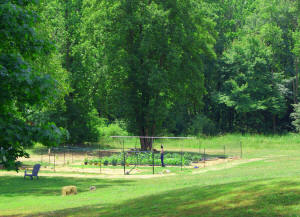 ised bed garden have progressed quite
nicely, and we have already been enjoying our own home-grown
food. The first treats from the garden were radishes. They came
up quickly, and matured just as fast. Soon afterward, the
lettuce began to produce... BIG TIME!. We are pulling the
lettuce leaves from around the outside of the plant, and they
keep producing. We are having a lot of salads, and giving the
excess to the bunnies and other family members.
ised bed garden have progressed quite
nicely, and we have already been enjoying our own home-grown
food. The first treats from the garden were radishes. They came
up quickly, and matured just as fast. Soon afterward, the
lettuce began to produce... BIG TIME!. We are pulling the
lettuce leaves from around the outside of the plant, and they
keep producing. We are having a lot of salads, and giving the
excess to the bunnies and other family members.
The jalapeņo and various other
peppers are coming in like mad. To celebrate our first pepper
harvest, the children decided to have a salsa recipe contest.
The kids worked and worked on their own concoctions, and Rebecca
and I were the judges. I really must learn to suppress my facial
expressions when tasting the food product of my chef-like children. Hey! It was
GREAT!
From the Three Sisters Bed, we have
begun to harvest yellow squash, corn, and zucchini. There are
dozens of new
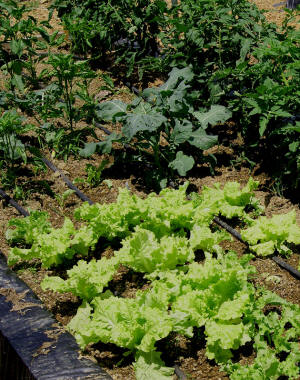 fruit
on the plants, and they are growing to picking size quicker than
we expected. Cucumbers, especially the
pickling kind, are abundant, and the salad cucumbers are just
starting to come of age. The string-trellis tomato vines are
covered with over 100 tomatoes of various sizes that will be
mature, red, and ripe for the picking within a week or so.
fruit
on the plants, and they are growing to picking size quicker than
we expected. Cucumbers, especially the
pickling kind, are abundant, and the salad cucumbers are just
starting to come of age. The string-trellis tomato vines are
covered with over 100 tomatoes of various sizes that will be
mature, red, and ripe for the picking within a week or so.
With the radishes all harvested, we
used the newly freed-up space to plant pumpkins. Hopefully, they
will be ready right around mid-October. Also, I'm not sure if it
was because of the unusually early heat this year or what, but
we had very little success with our spinach. We harvested and
ate some, but it just wasn't hardy. We pulled the last of the
spinach out of the raised bed and planted purple hull peas in
its place. Purple hull peas are a southern delight, and they
just love heat, something of which we have plenty.
The children have slowly become more
an more attracted to the garden since everything is blooming and
producing food. They're amazed at how fast the zucchinis and
yellow squash grow (but we still can't get them to eat either).
They have all participated in the planting and harvest, and one
or two have helped with the weeding. It has certainly been a
learning experience for all of us.
Here are a few pictures of the
garden. Click on them to zoom.
Raised Bed Vegetable Garden - April 24 - 2012
_small.jpg) When we started this part of our micro farm
project, we knew very little about raised bed gardens.
Our parents had gardens when
we were children, but as adults, we've never undertaken such a
project. Rebecca purchased a book titled
Mini Farming: Self-Sufficiency on 1/4 Acre by
Bret Markham., and it proved
to be an invaluable resource which I repeatedly reference as the
project progresses. Additionally, various gardening blogs,
videos, and governmental and educational websites have provided
guidance, albeit sometimes incorrect or dated.
When we started this part of our micro farm
project, we knew very little about raised bed gardens.
Our parents had gardens when
we were children, but as adults, we've never undertaken such a
project. Rebecca purchased a book titled
Mini Farming: Self-Sufficiency on 1/4 Acre by
Bret Markham., and it proved
to be an invaluable resource which I repeatedly reference as the
project progresses. Additionally, various gardening blogs,
videos, and governmental and educational websites have provided
guidance, albeit sometimes incorrect or dated.
Being on a shoestring budget, my first big investment was the
purchase of 18 used railroad crossties for the sum of $90.
They're heavy enough to stay in place and they'll last forever.
For peace of mind, I used heavy gauge plastic to create a watertight
and airtight barrier between the crossties and the garden bed. I
used cheap 1"x 2"s as stakes to hold the crossties in place,
then filled and packed dirt between the beds to stabilize them.
Shimming with bricks to level the crossties created beds between
12-16" of amended and finely tilled topsoil. After their
installation, the
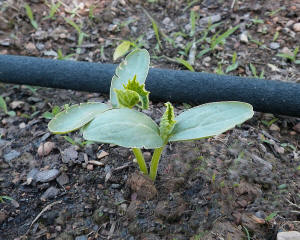 18
crossties established three 24' x 5' beds for a total of 365
square feet of garden space.
18
crossties established three 24' x 5' beds for a total of 365
square feet of garden space.
Filling three very large beds with
dirt could have been quite a chore. Fortunately, we have access to
my father's (Paw Paw) tractor equipped with a
bucket. It made short work of
gathering topsoil from our little cove. The soil is dark and rich
(probably from 22 years of my
fertilizer and expensive topsoil running off my lawn).
Unfortunately, the dirt is also riddled with fescue sod and
clover roots a foot deep. We hand hoed one of the beds because
out tiller was on the fritz. I ended-up renting a small tiller
for the next weekend. It was $40 well spent. I added some peat
and bagged garden soil to make it a little fluffier and help it
hold moisture, then pulverized it. I wanted to add vermiculite,
but I couldn't find any locally before planting time. I'll add
some in the fall.
With the beds in place, our next
concern was protecting our hard work from total destruction by
our goats and chickens, or by the many deer visitors we receive
in our little cove.
The best deal I could find was 5' high welded-wire fence.
It may seem short to some, but our deer are small than some, and
I'm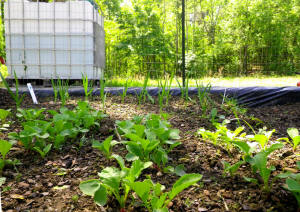 keeping my fingers crossed they'll not be tempted enough to
attempt the jump.
purchased two 100' rolls of fencing and a dozen or so 6.5'
t-posts. I constructed an inexpensive gate using 2" PVC pipe and
left-over fencing. Once it was all set-up, it worked great.
keeping my fingers crossed they'll not be tempted enough to
attempt the jump.
purchased two 100' rolls of fencing and a dozen or so 6.5'
t-posts. I constructed an inexpensive gate using 2" PVC pipe and
left-over fencing. Once it was all set-up, it worked great.
With the bulk of the infrastructure completed, we
decided to begin planting
our garden although it was just a little early for some of the
plants. This year it's been extremely mild, and everything is
about a month ahead. On our first planting, we sowed radishes,
garlic, cucumbers, peas, corn, and planted tomato seedlings. A
week or so later, we followed-up with lettuce, lima beans, pole
beans, okra, squash, zucchini, a variety of peppers, watermelon,
cantaloupe, onions, carrots. As of mid-late April, everything is
up and looking hardy. We had a three close calls with frost, but
we beat the monster.
_small.jpg) We
are slowly learning what is good to plant together and what is
not. I don't think we made too many bad mistakes this first time
around. We are definitely experimenting with the "Three Sisters"
planting scheme of squash, corn, and climbing beans and peas. I
am also trying a few neat ideas I discovered from the Backyard
Farming book and online. For instance, we are training our
tomatoes and some of our cucumbers to climb a string trellis to
save room in the bed.
We
are slowly learning what is good to plant together and what is
not. I don't think we made too many bad mistakes this first time
around. We are definitely experimenting with the "Three Sisters"
planting scheme of squash, corn, and climbing beans and peas. I
am also trying a few neat ideas I discovered from the Backyard
Farming book and online. For instance, we are training our
tomatoes and some of our cucumbers to climb a string trellis to
save room in the bed.
Keeping the garden watered through our hot dry
summers is a top priority, especially when we may be out of town
several days at a time. To solve this problem, we purchased a
used (like new) 275 gallon water tote (Craigslist $50), a
two-zone watering timer, some soaker watering hoses ($11ea), and
a variety of adapters and splitters to make it all work. I'm
currently experimenting with getting a good even water coverage
in all three beds. I may have to add another two-zone watering
timer before all is said and done.
 In
addition to building raised beds for vegetables, we also used
the new fenced area to plant some grape vines, blueberries, and
blackberries. Additionally, we have placed a variety of
containerized fruit plants in the enclosure including fig trees,
strawberries, and a very hardy cherry tomato (see here blooming
in mid-April).
In
addition to building raised beds for vegetables, we also used
the new fenced area to plant some grape vines, blueberries, and
blackberries. Additionally, we have placed a variety of
containerized fruit plants in the enclosure including fig trees,
strawberries, and a very hardy cherry tomato (see here blooming
in mid-April).
So, will we save money on groceries? Probably not this year. The
expense of establishing the garden outweighs the fiscal benefit,
at least the first year. Next year will be a different story.
We'll have our own compost (thanks to the goats, rabbits, and
all organic kitchen waste), and labor will be minimal compared
to this year. We have to remember the other benefits too. In
addition to providing the family with fresh healthy food, we're
all learning a lot about plants, how they grow, and what they
need. I also believe the kids will be much more inclined to eat
the veggies they've helped grow.
Getting Started...
March 15, 2012
Sometime in mid 2011, Rebecca mentioned that she represents the
first generation in her family that hadn't learn the old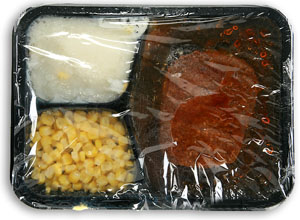 -timey
methods of self sufficiency. Ours is the age of convenience.
Everything comes from the store processed, pre-packaged, and
ready for mass consumption. Just pop it in the microwave,
washer, or whatever electric device fits the need. We take for
granted our day to day needs because they are typically right
there at our fingertips or just a short drive away. In our
travels, we have visited many parks and museums that display and
demonstrate the tools of the past, and we're always amazed at
how resourceful and creative people can be. These folks knew how
to solve problems and prepare for the worse. They raised,
preserved, and prepared their own food, made their own clothes,
heated their own homes, and taught their children how to do the
same. Life was tougher back then, but their skills could sustain
them when times were bad. Those skills are important, even
(especially) in this day and time.
-timey
methods of self sufficiency. Ours is the age of convenience.
Everything comes from the store processed, pre-packaged, and
ready for mass consumption. Just pop it in the microwave,
washer, or whatever electric device fits the need. We take for
granted our day to day needs because they are typically right
there at our fingertips or just a short drive away. In our
travels, we have visited many parks and museums that display and
demonstrate the tools of the past, and we're always amazed at
how resourceful and creative people can be. These folks knew how
to solve problems and prepare for the worse. They raised,
preserved, and prepared their own food, made their own clothes,
heated their own homes, and taught their children how to do the
same. Life was tougher back then, but their skills could sustain
them when times were bad. Those skills are important, even
(especially) in this day and time.
So, we decided to begin the process of learning
some of the old-timey skills while applying some
of our modern knowledge.
by building a "Micro-Farm" at our Georgia home.
Nothing massive,
_small.jpg) and
nothing too high maintenance ( because we still
want to travel).
We are fortunate to live very near to my parents
and other family members, so we have some help
when we're away. However, I still want to
automate things so that feeding and watering
tasks will be minimal.
and
nothing too high maintenance ( because we still
want to travel).
We are fortunate to live very near to my parents
and other family members, so we have some help
when we're away. However, I still want to
automate things so that feeding and watering
tasks will be minimal.
The process of building started
well before Christmas. The plan
was to make Christmas gifts of
some of the animals and
supplies. My first step was to
convert an old screened-in
sandbox into a chicken coop, a
fiberglass greenhouse into a
goat shelter, and to erect some
goat-proof fencing. My
experience of raising a goat as
a child taught me that goats are
brilliant escape artists. That
skill, however, is about the
only brilliant skill goats have.
At
he time of this post, we have
four goats, four rabbits, and
eight chickens, I have made a
few fencing adjustments here and
there, built a rabbit hutch,
built a portable chicken/rabbit
run, and built a new goat condo.
_small.jpg) We
are currently looking for more
laying hens
while building a raised-bed
garden area.
We
are currently looking for more
laying hens
while building a raised-bed
garden area.
This project has resulted in a
lot of work, but the benefits
are already
beginning to become evident. For
instance, Lee Thomas, our oldest
(12) has created a chore list
that assures the animals are fed
and watered daily. He did this
on his own with little
resistance from his siblings.
Additionally we are currently
harvesting about 3 eggs a day
from our four laying hens
(the other two are too young),
so we need more hens. The
children (and Rebecca and I) are
learning a lot about animals and
responsibility as a result of
this experience.
So, there you have it. We are
officially a family of
"micro-farmers." As I said
before, we certainly do not
intend to stop our
on-road adventures. I am
currently designing automatic
feeding and watering systems so
we can travel with some peace of
mind (and remember Paw Paw can
help too). I plan to publish
periodic updates as the farm
evolves, so keep an eye on
PB&J Adventures. In the
meantime, go somewhere, do
something!


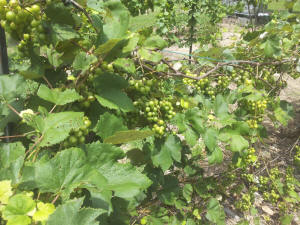
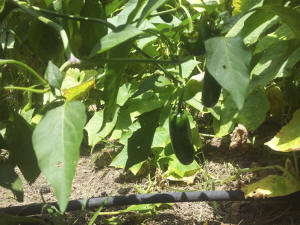
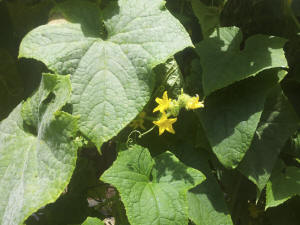
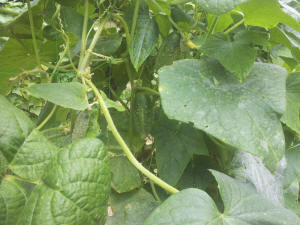
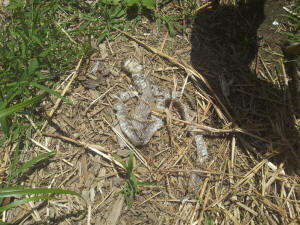
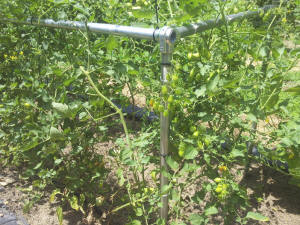

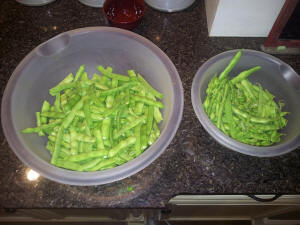
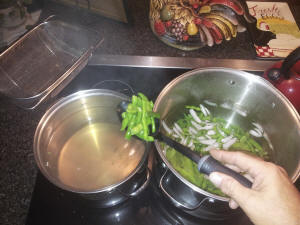
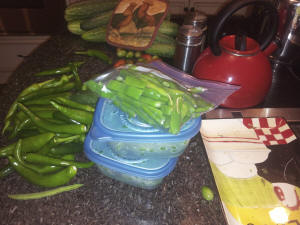
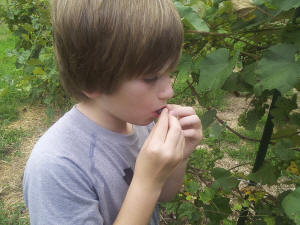
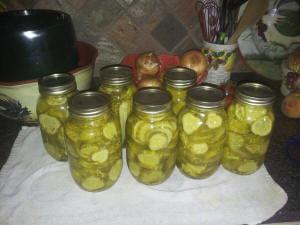
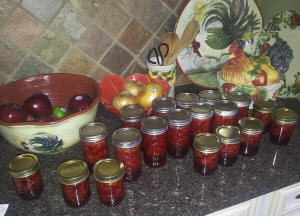

















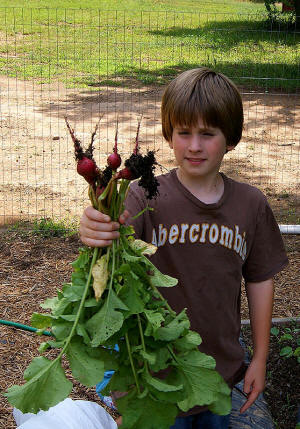
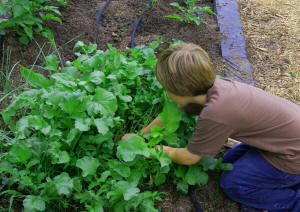
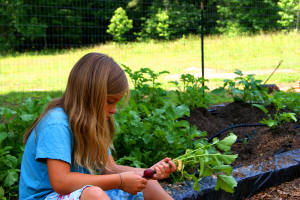
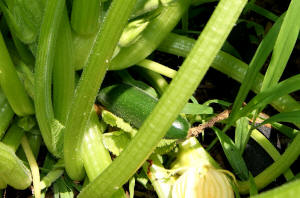
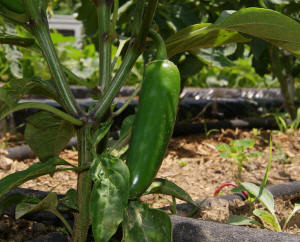
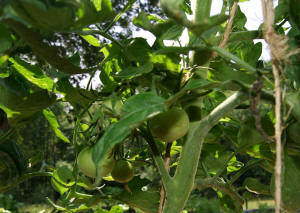
_small.jpg)


_small.jpg)

 -timey
methods of self sufficiency. Ours is the age of convenience.
Everything comes from the store processed, pre-packaged, and
ready for mass consumption. Just pop it in the microwave,
washer, or whatever electric device fits the need. We take for
granted our day to day needs because they are typically right
there at our fingertips or just a short drive away. In our
travels, we have visited many parks and museums that display and
demonstrate the tools of the past, and we're always amazed at
how resourceful and creative people can be. These folks knew how
to solve problems and prepare for the worse. They raised,
preserved, and prepared their own food, made their own clothes,
heated their own homes, and taught their children how to do the
same. Life was tougher back then, but their skills could sustain
them when times were bad. Those skills are important, even
(especially) in this day and time.
-timey
methods of self sufficiency. Ours is the age of convenience.
Everything comes from the store processed, pre-packaged, and
ready for mass consumption. Just pop it in the microwave,
washer, or whatever electric device fits the need. We take for
granted our day to day needs because they are typically right
there at our fingertips or just a short drive away. In our
travels, we have visited many parks and museums that display and
demonstrate the tools of the past, and we're always amazed at
how resourceful and creative people can be. These folks knew how
to solve problems and prepare for the worse. They raised,
preserved, and prepared their own food, made their own clothes,
heated their own homes, and taught their children how to do the
same. Life was tougher back then, but their skills could sustain
them when times were bad. Those skills are important, even
(especially) in this day and time._small.jpg)
_small.jpg)